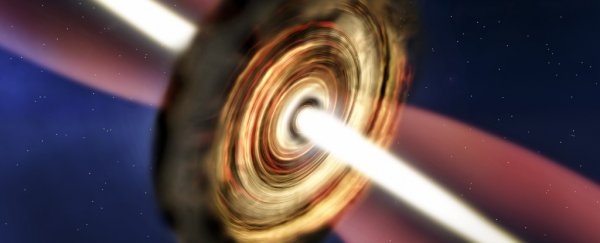Astronomers have identified a young star that's already 30 times more massive than our Sun, and it's in our own galaxy, about 11,000 light-years away from Earth.
As the young heavyweight continues to collect matter from its parent molecular cloud, researchers hope to observe it reaching 'adulthood', allowing them to better understand how massive stars form in the Universe.
"An average star like our Sun is formed over a few million years, whereas massive stars are formed orders of magnitude faster - around 100,000 years," said team leader John Ilee, from the University of Cambridge in the UK.
"These massive stars also burn through their fuel much more quickly, so they have shorter overall lifespans, making them harder to catch when they are infants."
The star - called G11.92-0.61 MM1, or just MM1 for short - resides in a region that's perfect for star formation, because it's very cold and very dense.
These areas are known as stellar nurseries, and they're very hard to observe with normal telescopes, because astronomers can't see through the dense clouds of molecular material that often shroud infant stars.
To observe MM1, Ilee and his team used the Submillimetre Array (SMA) in Hawaii and the Very Large Array (VLA) in New Mexico. These two telescopes use longer wavelengths than most other telescopes, allowing them to see through the dense clouds and actually observe MM1.
Using these observations, the team was able to measure the amount of radiation coming from the stellar nursery, and they suggest that MM1 is surrounded by a Keplerian disc - a large disc of matter that spins faster the closer it is to the star, and slower as it gets further away.
"This type of rotation is also seen in the Solar System - the inner planets rotate around the Sun more quickly than the outer planets," Ilee explained. "It's exciting to find such a disc around a massive young star, because it suggests that massive stars form in a similar way to lower mass stars, like our Sun."
The team's findings build off a summer research project led by Pooneh Nazari from the University of St. Andrews in Scotland, who calculated the mass of MM1 to be about 30 times that of the Sun.
In fact, Nazari and his colleagues think the disc around the star could be hiding even more mass, leading to the formation of other companion stars.
"Our theoretical calculations suggest that the disc could, in fact, be hiding even more mass under layers of gas and dust," said Nazari's team member, Duncan Forgan. "The disc may even be so massive that it can break up under its own gravity, forming a series of less massive companion protostars."
The researchers are now planning to use the Atacama Large Millimetre Array (ALMA) in Chile to scan the region to see if there are companion stars hiding inside the extremely dense disc.
If there are, we might learn a great deal more about how stellar nurseries work, and how massive stars grow in the Universe - a process that's been extremely hard to study without the world's best telescopes.
The study has been published in Monthly Notices of the Royal Astronomical Society.
